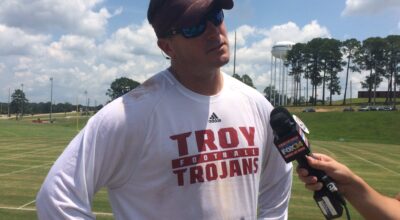Alcohol sales may improve safety
Published 8:10 am Thursday, September 22, 2011
There has been some concern among students, faculty, administrators, and the rest of the Troy community at the prospect of serving alcoholic beverages inside the stadium at Troy University during football games.
Concerns focus primarily on the perceived increased rowdiness that may result from fans having access to alcoholic beverages during football games. While these concerns are well-intended and should be taken into consideration; at large evidence suggests that these concerns are unfounded.
Evidence from experts who have studied the control of alcohol at stadiums actually suggests that serving alcohol at stadiums during sporting events may actually increase the level of safety before, during, and after events. There are several reasons for this.
The enforcement of alcohol bans inside the stadium requires a tremendous amount of policing resources. Allowing the serving of alcoholic beverages during events will free up public safety personal to focus exclusively on subduing rowdy fans, who are likely be rowdy regardless of any alcohol restrictions inside the stadium, rather than on policing responsible sport fans.
Banning alcohol inside the stadium during events also increases the amount of drinking occurring before the game at off-premise locations, leading to increased drunk driving and drinking in unsupervised situations. Boyes and Faith published a 1993 study of the Arizona State University ban of alcohol sales, and found up to a 40% increase in the BAC levels of drivers stopped by police, both before and after the games, after the ban on alcohol inside the stadium was implemented. This occurred despite an increase in drunk driving penalties over this period.
Even if fans consume alcohol responsibly tailgating just outside the stadium, many fans linger outside the stadium consuming beverages until just right before the game starts, creating a potentially dangerous rush to the stadium. The same rush occurs during half-time when fans exit the stadium to consume more alcoholic beverages and then return.
Besides the risk of rushing fans coming in and out of the stadium, it also encourages binge drinking among fans, who consume dangerous amounts of alcohol in a short amount of time due to the unavailability of alcohol during the game. In their 1993 of Arizona State University’s ban on alcohol sales, Boyes and Faith found that fans increased their consumption of alcohol both prior to and after the game due to the alcohol sales restriction.
They argued that this alone lead to more damaging effects than those associated with allowing alcohol sales within the stadium.
Drinking at unsupervised locations off-premise, binge drinking and fans rushing in and out of the stadium are far more likely to cause rowdy behavior and pose a risk to football fans than alcohol sales within the stadium. Gary Pearson and Arianna Sale, in a 2011 study of alcohol controls at soccer matches in Britain, and Stuart Frosdick in a 1998 study in the Journal of Stadium and Arena Management, found that the risk of rowdy behavior actually increased with alcohol restrictions.
So not only would alcohol sales within the stadium increase the enjoyment of the spectacle during Troy University Football games, drawing in more fans to Troy, it would also likely increase the safety for Trojan football fans and the community at large.
Daniel J. Smith
Assistant Professor
Troy University


